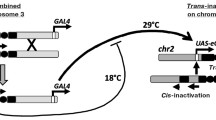Abstract
In D. melanogaster, the nuclear matrix protein EAST functionally interacts with the Su(Hw)-dependent insulator complex. The y2 allele, in which the MDG4 retrotransposon is inserted between enhancers and the gene promoter, was previously described. The Su(Hw) insulator sequence is present in the regulatory region of MDG4. An increase in the EAST protein concentration or inactivation of the Mod(mdg4)-67.2 protein, which is part of the Su(Hw)-dependent complex, results in tissue-specific repression of the yellow gene in the y2 allele. In the present work, the degree of EAST-dependent and Su(Hw)-dependent repression in different regions of the genome was analyzed using transposition of transgenes containing long terminal repeat (LTR) sequences of the MDG4 retrotransposon and the Su(Hw) insulator. As a result of genetic experiments, it was shown for the first time that EAST-dependent repression of the yellow gene is observed in the same transgenic lines of D. melanogaster as Su(Hw)-dependent repression. The obtained data confirm our earlier suggestion that the regulatory complex, which is formed on the LTR sequence and functionally interacts with the EAST protein, transfers the transgene to the nucleus regions with a high concentration of factors that repress transcription.

Similar content being viewed by others
REFERENCES
Wasser, M. and Chia, W., The EAST protein of drosophila controls an expandable nuclear endoskeleton, Nat. Cell Biol., 2000, vol. 2, pp. 268—275. https://doi.org/10.1038/35010535
Golovnin, A., Melnikova, L., Shapovalov, I., et al., EAST organizes Drosophila insulator proteins in the interchromosomal nuclear compartment and modulates CP190 binding to chromatin, PLoS One, 2015, vol. 10. e0140991. https://doi.org/10.1371/journal.pone.0140991
Melnikova, L., Shapovalov, I., Kostyuchenko, M., et al., EAST affects the activity of Su(Hw) insulators by two different mechanisms in Drosophila melanogaster, Chromosoma, 2017, vol. 126, pp. 299—311. https://doi.org/10.1007/s00412-016-0596-3
Spana, C. and Corces, V.G., DNA bending is a determinant of binding specificity for a Drosophila zinc finger protein, Genes Dev., 1990, vol. 4, pp. 1505—1515.
Gause, M., Morcillo, P., and Dorsett, D., Insulation of enhancer-promoter communication by a gypsy transposon insert in the Drosophila cut gene: cooperation between suppressor of hairy-wing and modifier of mdg4 proteins, Mol. Cell Biol., 2001, vol. 21, pp. 4807—4817. https://doi.org/10.1128/MCB.21.14.4807-4817.2001
Pai, C.Y., Lei, E.P., Ghosh, D., and Corces, V.G., The centrosomal protein CP190 is a component of the gypsy chromatin insulator, Mol. Cell., 2004, vol. 16, pp. 737—748. https://doi.org/10.1016/j.molcel.2004.11.004
Geyer, P.K. and Corces, V.G., Separate regulatory elements are responsible for the complex pattern of tissue-specific and developmental transcription of the yellow locus in Drosophila melanogaster, Genes Dev., 1987, vol. 1, pp. 996—1004.
Geyer, P.K., Spana, C., and Corces, V.G., On the molecular mechanism of gypsy-induced mutations at the yellow locus of Drosophila melanogaster, EMBO J., 1986, vol. 5, pp. 2657—2662.
Georgiev, P. and Kozycina, M., Interaction between mutations in the suppressor of Hairy wing and modifier of mdg4 genes of Drosophila melanogaster affecting the phenotype of gypsy-induced mutations, Genetics, 1996, vol. 142, pp. 425—436.
Mel’nikova, L.S., Krivega, I.V., Georgiev, P.G., and Golovnin, A.K., Nuclear matrix protein EAST is involved in regulation of transcription of the yellow gene in Drosophila melanogaster, Dokl. Biol. Sci., 2007, vol. 415, pp. 313—316.
Melnikova, L.S., Kostyuchenko, M.V., Krivega, I.V., et al., Mapping of the gypsy retrotransposon sequence responsible for the EAST-dependent repression in the yellow gene model system of Drosophila melanogaster, Russ. J. Genet., 2017, vol. 53, no. 9, pp. 988—997.
Golovnin, A.K., Molodina, V.V., Shapovalov, I.S., et al., LTR sequence of the MDG4 retrotransposon contains the MAD protein binding site that affects the EAST-dependent repression, Dokl. Biochem. Biophys., 2017, vol. 473, pp. 106—110. https://doi.org/10.1134/S1607672917020053
Robertson, H.M., Preston, C.R., Phillips, R.M., et al., A stable genomic source of P element transposase in Drosophila melanogaster, Genetics, 1988, vol. 118, pp. 461—470.
Cryderman, D.E., Morris, E.J., Biessmann, H., et al., Silencing at Drosophila telomeres: nuclear organization and chromatin structure play critical roles, EMBO J., 1999, vol. 18, pp. 3724—3735.
Fanti, L., Berloco, M., Piacentini, L., and Pimpinelli, S., Chromosomal distribution of Heterochromatin Protein 1 (HP1) in Drosophila: a cytological map of euchromatic HP1 binding sites, Genetica, 2003, vol. 117, pp. 135—147.
Carmena, M. and González, C., Transposable elements map in a conserved pattern of distribution extending from beta-heterochromatin to centromeres in Drosophila melanogaster, Chromosoma, 1995, vol. 103, pp. 676—684.
Chetverina, D.A., Elizar’ev, .P.V., Lomaev, D.V., et al., Control of the gene activity by polycomb and trithorax group proteins in Drosophila, Russ. J. Genet., 2017, vol. 53, no. 2, pp. 133—154.
Erokhin, M., Georgiev, P., and Chetverina, D., Drosophila DNA-binding proteins in polycomb repression, Epigenomes, 2018, vol. 2, no. 1. https://doi.org/10.3390/epigenomes2010001
Cremer, T., Kupper, K., Dietzel, S., and Fakan, S., Higher order chromatin architecture in the cell nucleus: on the way from structure to function, Biol. Cell, 2004, vol. 96, pp. 555—567. https://doi.org/10.1016/j.biolcel.2004.07.002
Fraser, P. and Bickmore, W., Nuclear organization of the genome and the potential for gene regulation, Nature, 2007, vol. 447, pp. 413—417. https://doi.org/10.1038/nature05916
Branco, M.R. and Pombo, A., Intermingling of chromosome territories in interphase suggests role in translocations and transcription-dependent associations, PLoS Biol., 2006, vol. 4. e138. https://doi.org/10.1371/journal.pbio.0040138
Chambeyron, S. and Bickmore, W.A., Does looping and clustering in the nucleus regulate gene expression?, Curr. Opin. Cell Biol., 2004, vol. 16, pp. 256—262. https://doi.org/10.1016/j.ceb.2004.03.004
Chakalova, L. and Fraser, P., Organization of transcription, Cold Spring Harbor Perspect. Biol., 2010, vol. 2. a000729. https://doi.org/10.1101/cshperspect.a000729
ACKNOWLEDGMENTS
This work was financially supported by the Russian Science Foundation (project no. 18-14-00295).
Author information
Authors and Affiliations
Corresponding author
Ethics declarations
Conflict of interests. The authors declare that they have no conflict of interest.
Statement on the welfare of animals. All applicable international, national, and/or institutional guidelines for the care and use of animals were followed.
Additional information
Translated by D. Novikova
Rights and permissions
About this article
Cite this article
Golovnin, A.K., Kostyuchenko, M.V., Georgiev, P.G. et al. Interrelation of EAST-Dependent and Su(Hw)-Dependent Repression in Transgenic Lines of Drosophila melanogaster. Russ J Genet 55, 295–300 (2019). https://doi.org/10.1134/S1022795419030074
Received:
Revised:
Accepted:
Published:
Issue Date:
DOI: https://doi.org/10.1134/S1022795419030074



